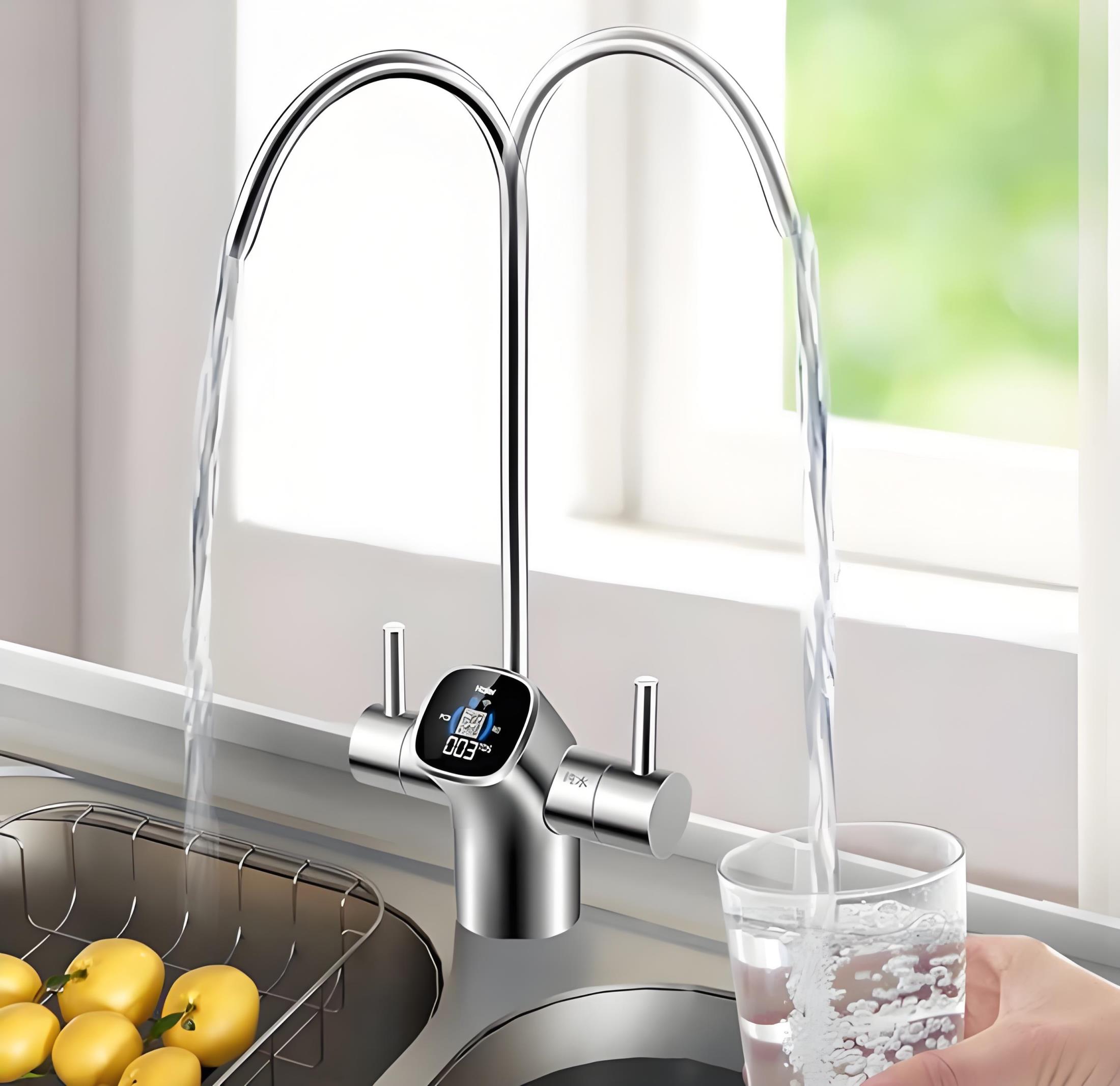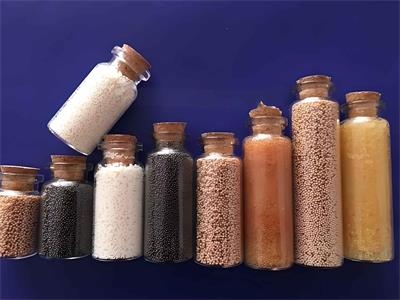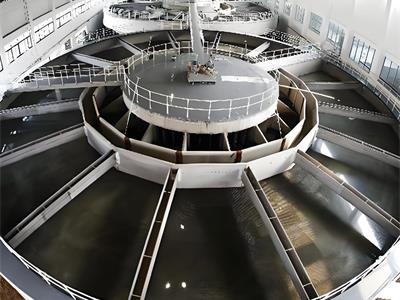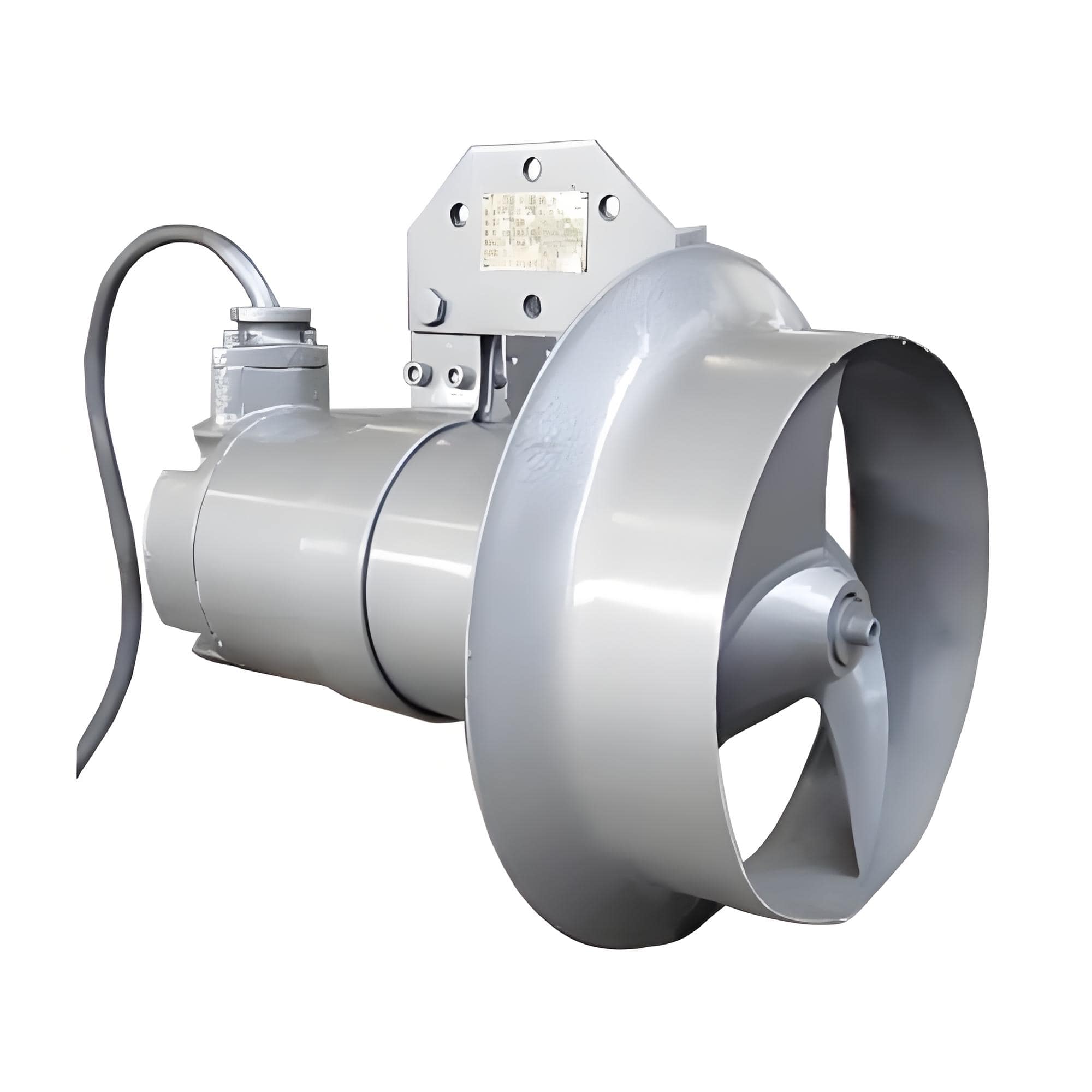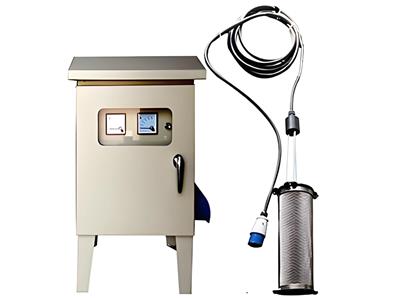- 2025-07-25
Advantages and Disadvantages of Reverse Osmosis (RO) Water
As more and more families install reverse osmosis water purifiers, some people begin to have such concerns: Is drinking reverse osmosis water safer and healthier than drinking tap water? Is it necessary to install a reverse osmosis water purifier at home? Next, this article will take you to explore the advantages and disadvantages of reverse osmosis water.
What is reverse osmosis
"Reverse osmosis" is a physical filtration process that relies on the ultra-high pressure generated by a high-pressure pump to force water molecules to move in the opposite direction of the natural osmotic gradient through a selective semipermeable membrane. In this process, RO water changes from a high-concentration solution to a low-concentration solution. The semipermeable membrane can filter out large particle pollutants at the molecular level and separate water from impurities. The purpose of the reverse osmosis system is to allow safe drinking water suitable for home use to flow directly from the tap.
What is reverse osmosis water?
RO water is high-purity water obtained after being treated by a reverse osmosis system. Because it does not contain bacteria and pollutants, it is usually used as clean drinking water for households, such as direct drinking, cooking, bathing, making coffee, and even pet care. It has been shown that reverse osmosis can remove 98% of a wide range of contaminants from water, including lead, asbestos, microorganisms, sediment, bacteria, fluoride, chloride, sulfate, heavy metals, industrial chemicals, pesticides, and total dissolved solids (TDS).
RO can also effectively remove these common ions in water:
Sodium
Magnesium
Calcium
Hydride
Arsenic
Chromium
Selenium
Radium
Barium
Cadmium
How does a reverse osmosis water filter purify water
Here's how a whole-house reverse osmosis system works.
Source water (such as seawater, well water, municipal water supply, rainwater, or river water) first passes through a pretreatment system that consists of a sediment filter, a GAC (granular activated carbon) filter, and a CTO (chlorine, taste, and odor) filter.
The role of pretreatment is to use materials such as quartz sand, activated carbon and activated carbon fiber to remove large particles, color, odor, suspended matter, viruses, bacteria, chlorine and other contaminants from the source water, and also protect the reverse osmosis system. The water treated at this stage is called primary treated water, which can be used by ordinary families, but cannot be drunk directly.Then, the pretreated water is pressed into the reverse osmosis membrane under the pressure of a pressure pump. The filtration accuracy of the reverse osmosis membrane is very high, and the pore size is as small as 0.0001 microns.The water treated by reverse osmosis is healthy, safe and pure, and will be stored in the water tank for easy access and direct drinking. At the same time, the concentrated brine (that is, wastewater) will be discharged from the system through a separate wastewater pipe.For those families who have higher requirements for the final water quality, the system needs to be equipped with a post-treatment device between the RO faucet and the reverse osmosis water tank, usually an activated carbon filter or a UV disinfection device. After the post-treatment device, the RO water tastes better and is safer to drink. After the final water flows out of the faucet, it can be drunk directly.FupengWater's reverse osmosis systems and home water softeners can solve a variety of household water quality problems. Click below to learn more and find solutions to meet your family's drinking water needs.
What are the benefits of drinking reverse osmosis water?
High level of contaminant purificationReverse osmosis water purification systems can effectively remove 99% of contaminants in water, such as harmful bacteria, viruses, heavy metals and chlorine. The water flowing out of the RO tap can be directly drunk and the water quality is very high.
Better tasteThe reverse osmosis system can effectively remove minerals and impurities in the water, bringing a more refreshing drinking experience. Using reverse osmosis water when cooking can ensure that the food is both delicious and hygienic. Hotels and restaurants often use reverse osmosis drinking water systems to make coffee, tea, juice and dishes. In addition, reverse osmosis water has no color and taste, and is fresher than tap water.
Reduce waterborne diseasesWaterborne diseases are caused by drinking contaminated water containing microorganisms or pathogens. Reverse osmosis water filtration systems can remove these pathogenic microorganisms. In addition, the semipermeable membrane can remove 99% of heavy metals, such as lead, manganese, arsenic and asbestos, to ensure the safety of drinking water.
Good for the skinSoft water is gentler than hard water and more friendly to the skin. Long-term use of RO reverse osmosis water can keep the skin smooth and moisturized, and reduce skin dryness and allergies.
Energy-saving alternativeUsually, the cost of obtaining high-quality water is relatively high, such as the traditional distillation method. But the reverse osmosis water system is more convenient and energy-efficient than the distillation system, and the water quality is just as good. The cost of obtaining reverse osmosis water is much lower than that of distilled water.
Wide range of applications, especially in water-scarce areasFor coastal areas, off-grid areas and remote areas, it is not easy to obtain clean and pollution-free water. Reverse osmosis water plants can be designed with different capacities and sizes according to customer needs to convert raw water such as seawater, rainwater, river water and well water into drinking water. In addition to household use, reverse osmosis technology is also widely used in industry, municipal administration, biopharmaceuticals, commerce and the military.
Cost-effectiveCompared to bottled water, reverse osmosis water is convenient and affordable. If you buy bottled water for your home drinking water now, you will spend a lot more money every year.A family uses about 100 gallons of water per day, of which only 2-3 gallons are for drinking. Assuming that bottled water costs between $3 and $10 per gallon, the cost of buying drinking water every day is $6 to $30. From a long-term investment perspective, even if the initial investment of a reverse osmosis water filter is higher, the annual savings are still considerable.
Reduce scale accumulationThe reverse osmosis system can soften hard water by removing calcium and magnesium ions that cause scale accumulation. Reducing total dissolved solids (TDS) and removing chemicals can reduce the possibility of corrosion, scaling and mineral deposits, thereby saving energy. Softened water will not clog pipes, coffee machines, faucets and shower heads, and can extend the life of household equipment and appliances.
Environmentally friendlyReverse osmosis is a natural process based entirely on physical principles, and no chemicals need to be added. Therefore, it is an environmentally friendly solution that does not generate any pollution sources. RO water can also replace bottled water and reduce the pollution of plastic bottles to the environment.
Disadvantages of reverse osmosis
The reverse osmosis water treatment method has advantages, but naturally there are also some disadvantages.
Bland tasteIt has to be said that RO (reverse osmosis) water has no taste and tastes very bland. Because of the lack of dissolved substances and minerals in the water, some people may not be used to this taste, which is one of the disadvantages of reverse osmosis water.
The impact of good mineral removal effectBefore reading this article, you may have heard that reverse osmosis water may have potential harm to kidneys and health. In fact, during the filtration process, reverse osmosis water removes electrolytes such as sodium, calcium, magnesium and potassium. So, is reverse osmosis water good for the human body?If you are more concerned about the electrolyte content in the water, it is best not to choose pure reverse osmosis water. In addition, for people with poor kidney function, it is best not to drink reverse osmosis water for a long time. The purity of reverse osmosis water is too high, which may affect the kidney's ability to normally excrete excess minerals in the water. Also, some municipal water systems add fluoride to the water, which is good for teeth, especially children's teeth, and can prevent tooth decay. But there is no fluoride in reverse osmosis water.
High wastewater volumeThe wastewater volume of reverse osmosis filters has always been a controversial issue. The common RO filter cartridges on the market generally have a wastewater ratio of 3:1, or even as high as 6:1. The wastewater ratio refers to the ratio of the amount of wastewater produced during the reverse osmosis process to the amount of pure water obtained in the end.This means that for every liter of pure water produced, 3 to 6 liters of wastewater may be produced, which may increase water bills. Although the wastewater to water ratio of some RO filters has now been reduced to 1:1 or even lower.
Slow filtration speedDuring the reverse osmosis process, water is forced to pass through the tiny pores on the reverse osmosis membrane to achieve filtration. Although this filtration method can make the filtration effect more refined than other methods, the speed is relatively slow. In addition, the reverse osmosis water purification system is also equipped with a pre-filter and an activated carbon filter, which will also prolong the time of the entire filtration process.
High initial costThe RO system is technologically advanced and has high filtration efficiency, so the cost is relatively high, which means that many families and businesses need to spend a lot of money when investing in the initial stage.
High maintenance costEven if the RO filter is installed, it still needs regular professional maintenance and replacement of consumables. The RO membrane generally needs to be replaced every 1-3 years, and the first three layers of filter material usually need to be replaced every 3-6 months. If the RO water filtration system is not regularly maintained and cleaned, the filtration efficiency of the RO membrane may decrease, which in turn affects the water quality of the produced water.
Acidic pH value of waterReverse osmosis water is weakly acidic due to the lack of alkaline substances such as minerals and soluble salts, and the pH value is generally between 6 and 7. Acidic water may cause a certain degree of slight corrosion risk to the pipe system.
Can RO water be drunk every day?
Is RO water safe and can it be drunk for a long time? This is a question that many readers are concerned about. Various answers can be found in forums and Google search results. The World Health Organization recommends not to drink only reverse osmosis water for a long time because it lacks the necessary trace elements and minerals that are beneficial to the human body.However, it is undeniable that the water we drink daily does contain some substances that are beneficial to the body. However, most of the minerals and trace elements needed by the human body mainly come from the food we eat every day. Therefore, even if you drink reverse osmosis water every day, it will not have much impact on the body. In contrast, what you should be more worried about are the excessive chemical pollutants, total dissolved solids (TDS), soluble salts and viruses in tap water or well water.
Do I need a reverse osmosis system?
Whether to invest in a reverse osmosis system depends on the quality of your local water supply and your requirements for the quality of the water produced.If the quality of your tap water is good, meets the drinking water standards, and has no obvious impurities and odors after inspection, it can be used directly for drinking and meeting daily needs.In addition, the water required for daily household water use, agricultural irrigation, and animal husbandry generally does not require high-purity water. In these cases, you may not need to install a reverse osmosis filter. You can consider other more cost-effective water treatment systems, such as ultrafiltration systems, nanofiltration systems, or even simple water filters.But if you are not satisfied with the quality of your current water supply and want to drink healthy and delicious water at all times, then purchasing a reverse osmosis filtration system is a wise choice.
So, how to remineralize RO water?
Alkaline water does have many benefits, such as improving digestion and maintaining the body's acid-base balance. Even if you have a reverse osmosis filtration system installed at home, you can still equip it with an automatic mineralization system. Automatic mineralization systems will add the right amount of minerals, such as calcium and magnesium, to the reverse osmosis water.If you want to remineralize your water, just buy the appropriate equipment online according to your specific needs. Or, you can also consult a water treatment service company for more professional advice.
Is there a better alternative solution than reverse osmosis?
If you are looking for the best way to get clean water at home, we still recommend using a reverse osmosis water filter, which is the simplest, most efficient and advanced water filtration system. It can not only improve the taste of water, but also remove all other contaminants in the water.If you need high-quality water for other purposes, you can also consider ion exchange, water softening, UV sterilization, ozone and distillation.The most cost-effective water filtration method is undoubtedly the activated carbon filter, which is suitable for situations where the raw water quality is good. The filtered water can also meet the daily household water needs. The activated carbon filter has a strong adsorption capacity, enough to remove organic matter, odor, color, pesticides, residual chlorine and fine particles in the water. In addition, the activated carbon filter is easy to install and has very low maintenance and installation costs. Most importantly, it does not produce too much wastewater.
Final words
After reading this article, I believe you have a certain understanding of the pros and cons of RO water. If you are still not sure whether the RO system is right for you and your family, you might as well leave your water treatment needs to FupengWater.We specialize in providing the highest quality RO purification systems, including under-sink water filtration systems, whole-house RO systems, RO containers, laboratory reverse osmosis systems, and solar desalination RO purifiers.You can test the water quality first. Our engineers will use their expertise to tailor a system for you, committed to providing the most cost-effective and durable water filtration solutions, including equipment installation and maintenance. Our goal is to allow you to drink healthy, safe and fresh water anytime, anywhere at an affordable price.

